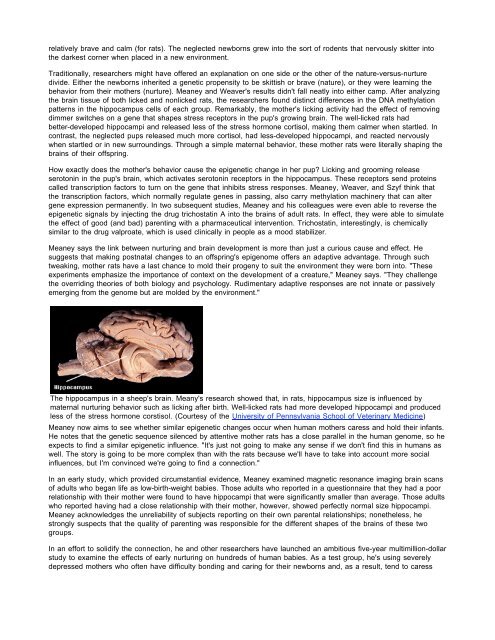DNA Is Not Destiny | Living World | DISCOVER Magazine
DNA Is Not Destiny | Living World | DISCOVER Magazine
DNA Is Not Destiny | Living World | DISCOVER Magazine
You also want an ePaper? Increase the reach of your titles
YUMPU automatically turns print PDFs into web optimized ePapers that Google loves.
elatively brave and calm (for rats). The neglected newborns grew into the sort of rodents that nervously skitter into<br />
the darkest corner when placed in a new environment.<br />
Traditionally, researchers might have offered an explanation on one side or the other of the nature-versus-nurture<br />
divide. Either the newborns inherited a genetic propensity to be skittish or brave (nature), or they were learning the<br />
behavior from their mothers (nurture). Meaney and Weaver's results didn't fall neatly into either camp. After analyzing<br />
the brain tissue of both licked and nonlicked rats, the researchers found distinct differences in the <strong>DNA</strong> methylation<br />
patterns in the hippocampus cells of each group. Remarkably, the mother's licking activity had the effect of removing<br />
dimmer switches on a gene that shapes stress receptors in the pup's growing brain. The well-licked rats had<br />
better-developed hippocampi and released less of the stress hormone cortisol, making them calmer when startled. In<br />
contrast, the neglected pups released much more cortisol, had less-developed hippocampi, and reacted nervously<br />
when startled or in new surroundings. Through a simple maternal behavior, these mother rats were literally shaping the<br />
brains of their offspring.<br />
How exactly does the mother's behavior cause the epigenetic change in her pup Licking and grooming release<br />
serotonin in the pup's brain, which activates serotonin receptors in the hippocampus. These receptors send proteins<br />
called transcription factors to turn on the gene that inhibits stress responses. Meaney, Weaver, and Szyf think that<br />
the transcription factors, which normally regulate genes in passing, also carry methylation machinery that can alter<br />
gene expression permanently. In two subsequent studies, Meaney and his colleagues were even able to reverse the<br />
epigenetic signals by injecting the drug trichostatin A into the brains of adult rats. In effect, they were able to simulate<br />
the effect of good (and bad) parenting with a pharmaceutical intervention. Trichostatin, interestingly, is chemically<br />
similar to the drug valproate, which is used clinically in people as a mood stabilizer.<br />
Meaney says the link between nurturing and brain development is more than just a curious cause and effect. He<br />
suggests that making postnatal changes to an offspring's epigenome offers an adaptive advantage. Through such<br />
tweaking, mother rats have a last chance to mold their progeny to suit the environment they were born into. "These<br />
experiments emphasize the importance of context on the development of a creature," Meaney says. "They challenge<br />
the overriding theories of both biology and psychology. Rudimentary adaptive responses are not innate or passively<br />
emerging from the genome but are molded by the environment."<br />
The hippocampus in a sheep's brain. Meany's research showed that, in rats, hippocampus size is influenced by<br />
maternal nurturing behavior such as licking after birth. Well-licked rats had more developed hippocampi and produced<br />
less of the stress hormone corstisol. (Courtesy of the University of Pennsylvania School of Veterinary Medicine)<br />
Meaney now aims to see whether similar epigenetic changes occur when human mothers caress and hold their infants.<br />
He notes that the genetic sequence silenced by attentive mother rats has a close parallel in the human genome, so he<br />
expects to find a similar epigenetic influence. "It's just not going to make any sense if we don't find this in humans as<br />
well. The story is going to be more complex than with the rats because we'll have to take into account more social<br />
influences, but I'm convinced we're going to find a connection."<br />
In an early study, which provided circumstantial evidence, Meaney examined magnetic resonance imaging brain scans<br />
of adults who began life as low-birth-weight babies. Those adults who reported in a questionnaire that they had a poor<br />
relationship with their mother were found to have hippocampi that were significantly smaller than average. Those adults<br />
who reported having had a close relationship with their mother, however, showed perfectly normal size hippocampi.<br />
Meaney acknowledges the unreliability of subjects reporting on their own parental relationships; nonetheless, he<br />
strongly suspects that the quality of parenting was responsible for the different shapes of the brains of these two<br />
groups.<br />
In an effort to solidify the connection, he and other researchers have launched an ambitious five-year multimillion-dollar<br />
study to examine the effects of early nurturing on hundreds of human babies. As a test group, he's using severely<br />
depressed mothers who often have difficulty bonding and caring for their newborns and, as a result, tend to caress


